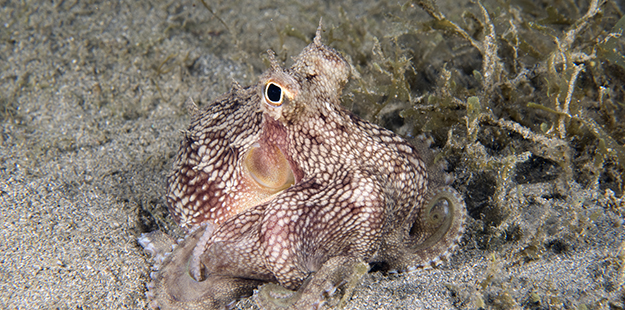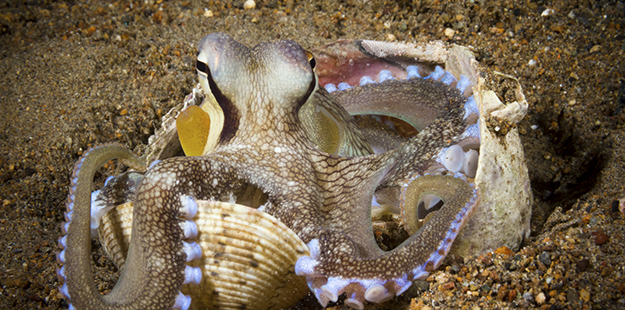Wakatobi’s Nut Job
Encounters with the comically clever coconut octopus
Humans like to believe we are unique in the animal kingdom. We walk on two legs, use tools, and have the ability to learn and adapt to changing environments. A few of our primate relatives show rudimentary talents in these areas, but we certainly wouldn’t expect a small, spineless sea dweller to master similar abilities. But that’s exactly what observant divers and snorkelers may discover in the waters of Wakatobi, where a discarded coconut shell may hold one of the cleverest animals in the ocean.

This coconut octopus was on a nighttime hunt for crabs and shrimp as she patrolled the sandy area near the turtle grass on the House Reef. Photo by Walt Stearns
A vulnerable nature
At first glance, there’s nothing remarkable about Amphioctopus marginatus. This medium-sized cephalopod is found throughout the tropical Indian Ocean, where it spends nights hunting shrimp, crabs, and clams in muddy or sand-bottom bays and lagoons. A network of dark lines on its body account for A. marginatus’ common name: the veined octopus. It’s a species well known to fishermen, who capture it by traps and trawls, and it’s also a fixture on Chinese menus, where it is known as saa liu, or sand bird.
To overcome this vulnerability, the veined octopus assembles a set of body armor, which has led to this species’ second nickname: the coconut octopus.
A veined octopus also presents a tasty treat to a variety of marine predators, and this can create a problem. The sand and mud flats where these octopus roam provide little or no natural cover. Like other members of the Octopodidae family, the veined octopus’ bag of tricks includes shape shifts, color changes, jet propulsion and the ejection of ink clouds. But escape isn’t always possible, and burrowing into the sand isn’t an effective deterrent against predators that can simply dig out or wash away enveloping sediment. To overcome this vulnerability, the veined octopus assembles a set of body armor, which has led to this species’ second nickname: the coconut octopus.
The shell game; a self-armoring cephalopod
Between 1999 and 2008, a team of research divers from Australia’s Victoria Museum spent hundreds of hours observing veined octopus in the waters of Indonesia’s Sulawesi region. They soon discovered one of the octopus’ common defensive strategies, which is to use discarded clam shells to create armored burrows. At times, the divers would also encounter an octopus carrying one or more shells as they moved about. At first it was assumed they were fetching new materials for a lair, but it was then realized that these shells were not building material, but body armor. While using one or more tentacles to probe the sand for meals, the veined octopus would hold on to one or more shells with its other tentacles, arranging them with the concave surfaces to the outside. When threatened, the shells would be pulled tighter around the octopus’ body, creating a protective suit of armor.
This funny clip shows the coconut octopus rolling around in a coconut shell.
These shell carriers would sometimes slither across the bottom in typical octopedal fashion, but at other times they would form themselves into a ball, with just two tentacles sticking out from their shell armor. These two tentacles were deployed like rigid limbs to move the octopus across the sea floor. The researchers labeled this lumbering bipedal gait as “stilt walking.” The only other octopus known to move about on two legs is the algae octopus, which uses this technique for what biologists call cryptic locomotion. In other words, it’s trying to fool predators by moving its camouflaged body about like a drifting clump of algae. By contrast, a shell-carrying veined octopus doesn’t stand a good chance of blending in. The shells provide no immediate concealment benefit, and are instead carried for potential defense.
A nutty upgrade
When studying sites near human settlements, the research team discovered what they considered an adaptive behavior. Instead of using clam shells, veined octopus were scavenging the discarded halves of coconut shells to create burrows and body armor. In comparison to a clam, a coconut shell is lighter and offers more volume within its hemispherical interior. Since many species of octopus are known to be quite intelligent, it wasn’t surprising that the veined octopus would take advantage of this new form of upgraded protection, and switch from clams to coconuts when the opportunity arose. What was less expected was the other things these clever creatures would do with their newfound technology.

Using one or more tentacles to probe the sand for meals, the veined octopus will hold on to shells with its other tentacles, arranging them with the concave surfaces to the outside. Photo by Walt Stearns
Julian Finn, a lead researcher on the project, recalls the first time one of these octopuses revealed a new trick. The team was working in an area of soft bottom littered with coconut shells. They were documenting the work of an octopus that was meticulously excavating coconut shells. After using its tentacles to free a shell from the mud, the octopus then jetted the interior clean of debris and stacked the shell facing upwards. “I could tell that the octopus, busy manipulating coconut shells, was up to something, but I never expected it would pick up the stacked shell and run away,” Finn recalls. The event, which was captured on video, shows the octopus crawling into a shell, extending its tentacles over the shell’s rim, and scurrying away with its prize. “It was an extremely comical sight—I have never laughed so hard underwater,” Finn says.
Like others of its kind, the coconut octopus has a short life span – often only three years.
The same octopus was later seen procuring a second shell, and pulling the two together to form a perfect ball of armored protection. The resulting video made this little cephalopod famous, and coined the nickname “coconut octopus.” In the years since, these animals have been seen engaging in even more unusual behavior. They may fit themselves into a pair of half shells, sitting inside while extending tentacles to crawl across the bottom, instantly ready to pull the shells together at the hint of danger. At other times, they will join the two shells together and roll along like a ball. Perhaps most comical of all is when a shell-encased octopus resorts to its stilt-walking behavior, creating the appearance of a walking coconut with two legs extended.
Watch the Smithsonian channel’s coconut-carrying octopus as she uses her tool to snatch a crab > page 2


